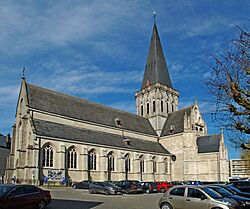Asse facts for kids
Quick facts for kids
Asse
|
|||
|---|---|---|---|

St Martin's Church (Sint-Martinuskerk)
|
|||
|
|||
| Country | Belgium | ||
| Community | Flemish Community | ||
| Region | Flemish Region | ||
| Province | Flemish Brabant | ||
| Arrondissement | Halle-Vilvoorde | ||
| Area | |||
| • Total | 49.64 km2 (19.17 sq mi) | ||
| Population
(2018-01-01)Lua error in Module:Wd at line 1575: attempt to index field 'wikibase' (a nil value).
|
|||
| • Total | Lua error in Module:Wd at line 1,575: attempt to index field 'wikibase' (a nil value). | ||
| Postal codes |
1730, 1731
|
||
| Area codes | 052 - 02 | ||
| Website | www.asse.be | ||
Asse (Dutch pronunciation: [ˈɑsə]) is a town in Belgium. It is located in the Flemish Brabant province. Asse is made up of several smaller towns. These include Asse itself, Bekkerzeel, Kobbegem, Mollem, Relegem, and Zellik.
Asse is also part of an area called the Pajottenland. In 2020, about 32,958 people lived in Asse. The total area of the town is 49.64 square kilometers. This means there are about 660 people living in each square kilometer.
Contents
History of Asse
Asse has a very long history. People have lived here for thousands of years.
Early Settlements
Asse was likely first settled by a group called the Celts. They were an ancient people. The name "Asse" might come from an old word meaning "water." This makes sense because stone tools have been found here. The land was also good for farming. It was higher than the wet plains nearby. This made it a good place for early communities to live.
Roman Times
Around the first century, the Romans built a military road. This road connected Asse to a Roman capital city. It also went north to a port. There might have been a Roman army camp near Asse.
Asse grew into an important settlement. It was at a key road crossing. Archaeologists have found many Roman items here. They found pottery and even parts of a Roman road. People also found many clay horse statues. These were probably offerings to a Roman goddess named Epona.
Frankish and Medieval Periods
Later, a group called the Franks arrived. They brought the Dutch language to the area. This happened in the late 300s and 400s.
During the time of Carolingian kings, Asse was part of Brabant. It was an important fortified place during Viking attacks. From 1085, Asse became part of the Duchy of Brabant. The local leader was called the "Lord of Asse."
Asse was important because it was at a crossroads. Trade routes went north-south and east-west. The soil was also good for farming. This made Asse a key regional center. It was also important for military reasons. Because of this, Asse was often involved in wars. It was even burned down several times.
Later Years
The St. Martin's Church in Asse became famous. People came there on pilgrimages. This was because of stories about miracles. One story was about a tree blossoming. Another was about a cross appearing.
Asse was a center for justice for a long time. During the French Revolution, it became a capital of a canton. A canton is like a small district.
Asse did not have many natural resources. It was also far from big rivers. And it was close to bigger cities like Aalst and Brussels. So, it never became a huge city for trade or industry. It remained a local market town. People in Asse brewed beer and sold local hops.
Today, many people who live in Asse travel to Brussels for work. Asse also has some light industries and shops.
Notable people from Asse
- Léonard de Selliers de Moranville (1803-1856): He was a lawyer and school inspector in Asse. His son, Antonin de Selliers de Moranville, became a top general in the Belgian Army in 1914. His granddaughter, Anne de Borman, was a tennis player. She played for Belgium in the 1920 and 1924 Summer Olympics.
- Femke Van den Driessche: She is a Belgian cyclist.
- Paul De Keersmaeker (1929 - 2022): He was a former mayor of Asse. He also served as a Secretary of State in the government.
See also
 In Spanish: Asse para niños
In Spanish: Asse para niños




